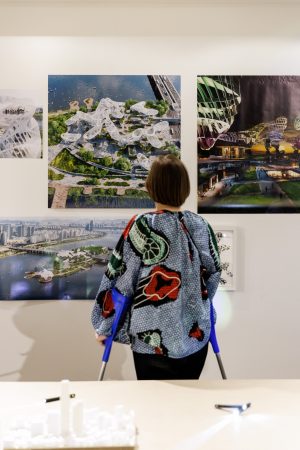J. MAYER H. wins first prize in the Kunst-am-Bau competition for the north gable of the Humboldt Forum, Berlin.
Project:
Südpfeil
Year:
2025
Location:
Berlin

“Südpfeil” was selected from over 120 submissions by national and international artists. Securing this commission at one of Europe’s most culturally significant venues is both a great honor and an extraordinary opportunity to contribute meaningfully to the Forum’s evolving narrative.
“Südpfeil” is a symbolically charged and visually bold intervention: a monumental arrow appears to pierce the stone façade of the Humboldt Forum, establishing a dramatic and thought-provoking presence in the heart of Berlin. Bridging past and present, the work engages critically with colonial legacies, cultural heritage, and the responsibilities of public institutions today.
“Südpfeil” is more than a sculpture—it is an invitation to debate. Positioned at one of Europe’s most symbolically charged cultural institutions, the work opens up space for public reflection on the legacies of empire, the ethics of display, and the entangled histories that define our global present. It aims to provoke, to question, and—ultimately—to inspire transformation.
Symbolism and Meaning
Migration and Connection — The Arrow Stork
One of the central inspirations for South Arrow is the story of the Arrow Stork. In 1822, a white stork was discovered in Germany with an African spear lodged in its body—evidence that it had migrated from central Africa. This unusual and now iconic finding provided the first scientific proof of bird migration and has since become a metaphor for global movement and interconnectedness. By referencing this story, South Arrowhighlights that migration is neither new nor exceptional—it is a deeply rooted, natural part of human and ecological history. To date, more than 25 arrow storks have been documented—silent witnesses to a world in motion.
A Flight Toward Truth — Shadows in the Stone
The arrow functions as a symbolic critique of the Humboldt Forum itself. Positioned to confront the reconstructed baroque façade of the former Berlin City Palace, it raises pointed questions about Germany’s colonial history, the architecture’s imperial legacy, and the contested narratives within museum collections. The work operates as both a gesture of challenge and an act of unveiling—inviting the public to examine whose histories are told and whose remain obscured.
Arrow of Affection— Toward Shared Future
At the same time, South Arrow leaves space for reconciliation and re-engagement. Echoing the idea of Cupid’s arrow, it also signifies the potential for a new relationship between the institution and the broader public. It acts as a bridge—encouraging dialogue, participation, and a more inclusive future for cultural spaces.
Drawn to the South — Lines of Memory and Power
The artwork’s physical orientation deepens its message: with its feathered end pointing north, the arrow becomes a literal “South Arrow.” This positioning alludes to enduring global asymmetries between the Global North and South, invoking histories of extraction, exploitation, and contemporary imbalances. It invites reflection on how historical power structures continue to shape present realities.



Team J.MAYER.H:
Jürgen Mayer H.
Hans Schneider
Jonas Schwarz
Vogelzug der Pfeilstörche/
Der Pfeilstorch von Leetza 1935 nach dem Fang,
Wissenschaftliche Arbeit von E. Schüz
Pfeilstörche, source: https://de.wikipedia.org/wiki/Pfeilstorch#/media/Datei:Rostocker_Pfeilstorch.jpg





